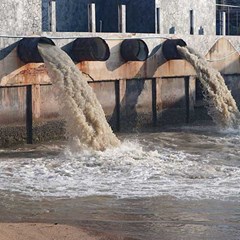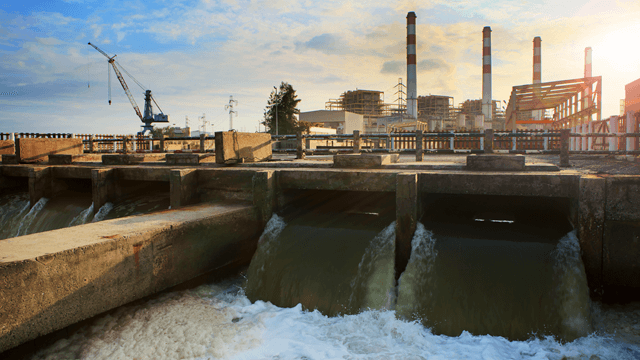Industrial Waste Water Treatment-- Customized Solutions for Effective Wastewater Treatment
Industrial Waste Water Treatment-- Customized Solutions for Effective Wastewater Treatment
Blog Article
Technologies and Advancements in Industrial Waste Water Therapy Technologies
The landscape of industrial wastewater therapy is undertaking a transformative change, driven by developments that enhance both performance and sustainability. Emerging modern technologies, such as membrane bioreactors and microbial gas cells, are redefining pollutant elimination procedures while adding to power generation. Moreover, resource healing methods are getting traction, straightening with circular economic situation concepts. As regulatory standards progress, the combination of AI and machine learning right into wastewater monitoring systems promises to make sure and improve procedures compliance. However, the full ramifications of these advancements raise important questions about their scalability and long-lasting influence on sector practices.
Review of Drainage Therapy Technologies
Wastewater therapy innovations include a variety of techniques developed to get rid of impurities from commercial effluents before their release into the setting. These modern technologies are essential for keeping environmental balance and ensuring conformity with ecological guidelines. The primary categories of wastewater therapy consist of physical, chemical, and biological approaches, each offering distinct purposes based upon the nature of the pollutants existing.

Biological therapy approaches employ bacteria to weaken raw material, making them especially reliable for organic-rich effluents. Techniques like activated sludge and biofilm reactors harness the natural destruction capabilities of germs, causing substantial reductions in biochemical oxygen demand (BODY)
Advanced Purification Strategies
Advanced filtration techniques represent an important advancement in the world of commercial wastewater therapy, enhancing the efficiency of contaminant removal processes. Industrial Waste Water Treatment. These methods include a series of innovations, consisting of microfiltration, ultrafiltration, nanofiltration, and turn around osmosis, which provide sequential barriers for various particle sizes and chemical structures
Microfiltration and ultrafiltration utilize membrane systems to eliminate suspended solids, germs, and bigger natural particles, enhancing the quality of effluent prior to further therapy. Nanofiltration links the gap in between ultrafiltration and turn around osmosis, properly getting rid of divalent ions and natural substances, hence lowering the lots on downstream procedures.
Reverse osmosis provides the greatest level of filtration by permitting just water and small molecules to travel through its semi-permeable membrane layers, making it suitable for recovering top notch water from industrial effluents. Recent innovations in membrane layer technology, consisting of the growth of more fouling-resistant and sturdy products, have actually considerably improved functional efficiency and reduced expenses.
Incorporating these innovative filtering techniques not just enhances the total treatment procedure however also adds to sustainability efforts by making it possible for water reuse and resource recuperation in industrial setups. (Industrial Waste Water Treatment)
Biological Therapy Developments

In addition, the advancement of engineered organic systems, such as membrane layer bioreactors (MBRs), integrates biological therapy with sophisticated membrane layer filtering. This combination enables greater effluent quality and reduced impact, making it suitable for space-constrained commercial facilities. Innovations in genetically crafted microorganisms have actually likewise arised, boosting the biodegradation of certain contaminants, such as drugs and heavy steels, that are typically testing to eliminate.
In addition, the application of bioaugmentation strategies, where helpful microorganisms are presented to enhance the existing organic treatment procedures, has actually shown encouraging lead to boosting treatment performance. These technologies collectively indicate a trend in the direction of even more efficient and sustainable organic treatment approaches that can adjust to the evolving intricacies of commercial wastewater streams. As industries remain to focus on environmental compliance, these organic technologies will play an important duty in wastewater management.

Resource Recuperation Techniques
In industrial setups, the combination of resource recuperation techniques has actually ended up being increasingly vital for boosting sustainability and reducing waste. These methods concentrate on extracting beneficial materials and power from wastewater streams, consequently transforming possible pollutants right into recyclable sources.
One famous approach is nutrition recovery, where nitrogen and phosphorus, commonly existing in excess in wastewater, are recorded and exchanged plant foods. This not just decreases environmental impacts yet also gives a circular economic climate solution for farming applications. In addition, innovations such as anaerobic food digestion enable the conversion of natural waste right into biogas, a renewable resource resource that can offset nonrenewable fuel source usage in industrial procedures.
In addition, advanced filtering and membrane layer technologies assist in the recuperation of industrial spin-offs such as steels and salts. These recovered materials can be reintegrated right into manufacturing procedures, decreasing the requirement for virgin sources.
Future Fads in Waste Water Management
As markets progressively focus on sustainability, the future of wastewater monitoring is readied to Read More Here undergo considerable makeovers. Technical advancements, such as expert system and maker understanding, will certainly enable more efficient monitoring and administration of wastewater systems. These innovations can anticipate upkeep requirements, enhance therapy processes, and improve decision-making, eventually minimizing operational expenses and environmental impact.
Furthermore, the integration of circular economy principles will certainly play a crucial role in wastewater monitoring. Industries are anticipated to change in the direction of systems that not only treat wastewater but additionally recoup beneficial sources, such as nutrients, water, Clicking Here and energy. This change will certainly lessen waste and promote the reuse of materials, aligning with international sustainability objectives.
Emerging treatment strategies, such as membrane layer bioreactors and advanced oxidation processes, will certainly additionally improve the effectiveness of wastewater therapy, enabling higher quality effluents ideal for reuse. Furthermore, regulatory structures are most likely to develop, emphasizing more stringent requirements for wastewater discharge and encouraging sectors to adopt cutting-edge therapy services.
Verdict
In final thought, the advancement of commercial wastewater treatment innovations shows a substantial shift towards improved performance and sustainability (Industrial Waste Water Treatment). Developments in sophisticated purification strategies, biological treatments, and resource healing approaches highlight the sector's commitment to environmental stewardship.
The landscape of industrial wastewater treatment is going through a transformative change, driven by technologies that enhance both efficiency browse around these guys and sustainability.Wastewater treatment innovations include a variety of techniques made to get rid of impurities from commercial effluents prior to their launch right into the environment.Harnessing the power of biological processes has led to significant innovations in the treatment of industrial wastewater.Additionally, the implementation of bioaugmentation strategies, where advantageous microbes are introduced to enhance the existing organic therapy procedures, has actually shown appealing results in improving treatment efficiency. These technologies jointly indicate a fad in the direction of more sustainable and efficient organic treatment approaches that can adjust to the evolving complexities of industrial wastewater streams.
Report this page